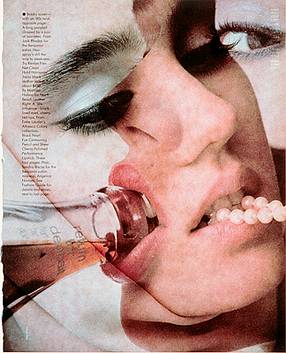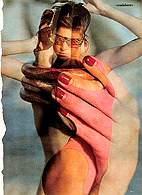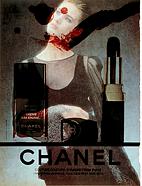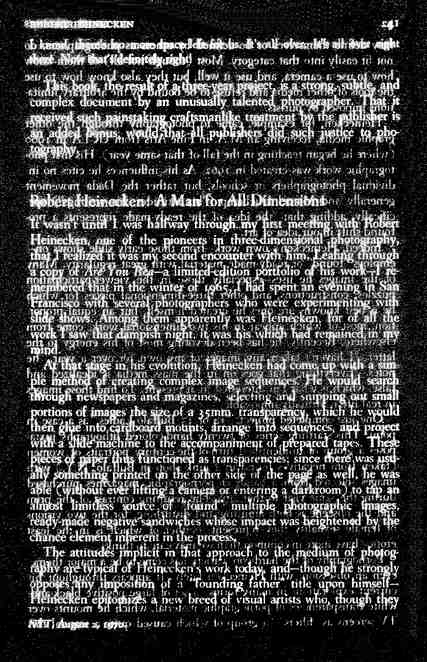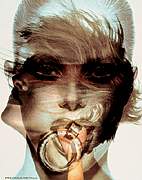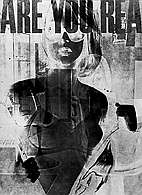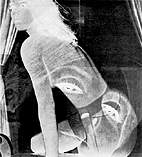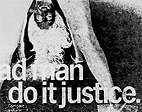| |

I first saw Are You Rea in 1972 when it arrived in Rochester at
a little photobook store called Light Impressions — a storefront
that seemed about 4×8 feet with a counter and a small exhibition
area with room for a half dozen prints to hang in a row above a display
rack containing the novelty items we called photobooks. Among the inventory
at the time: Les Krims' little portfolios; Lustrum Press' greatest hits;
the Canadian magazine Image Nation; mostly softcover fun, self-published
stuff.
As that time, mail-order
book sales were the main thrust of Light Impressions' business, and
their hope was to develop a mailing list that would allow them to open
up a vast market for what we all felt was going to be a massive revolution
in photobook publishing as well as a large revolution in art. (We may
note that a revolution has occurred, but it is not the one we had expected).
It is hard to imagine where else a publication such as Are You Rea
might have appeared, and at first glance I embraced it like a co-conspirator.
Are You Rea
was not a book at all, but more of a "guerilla" portfolio,
a "multiple" (as cheap artists' editions were sometimes called).
It certainly was something, but what…? A bunch of prints? pages?
photograms? page-o-prints? magazine-o-grams? Heineckenographs? If it
had a model at all, it was one of the Institute of Design portfolios
which had been very experimental, printed in various ways with a variety
of materials. The ID portfolios were mostly photographic, very modest
productions designed for the people who made them, which was a good
idea because no one else was interested. "Photography" was
what one saw at its best in Life magazine, at its worst in one's
own family album. Even the photographs of Aaron Siskind and Harry Callahan,
included in the ID portfolios, had no commercial value. Although 1970
is usually regarded as a turning point for photography; after some conspicuous,
lively auctions and a range of other activities, a market suddenly showed
up.
Clearly, whatever
else Are You Rea may have been, it was also the result of a printmaking
process: photo offset; ink on paper. Inexpensive and accessible, photo-offset
lithography could allow the small press or self-publisher to get out
work that otherwise could not have been commercially justified. Contrary
to modern assumptions, desktop publishing really began with the liberation
of printing; even mimeograph is desktop publishing, isn't it? And wasn't
the 1947 Stieglitz memorial portfolio also a pack of cheap reproductions,
never to be confused with the photographer's original fine prints? Are
You Rea was a portfolio, and it was cheap, so I bought it.
Thus did I meet
up with this curious and distinctive little portfolio, the diminutive
size of which gives no indication of its status as a first-rate cultural
event. It immediately fell into place with what I already knew about
Heinecken and his art since I had met him two years earlier at a workshop
at the Center of the Eye in Aspen, Colorado. I had hung a show of his
work at a gallery there and remember several things: 1) that Heinecken
had hair longer than my own, indicating a seriousness of counter-cultural
stance over a comparatively longer period of time; 2) that he was the
guy who went on an outing to a Minor White shrine just outside of Aspen,
called The Grottos, armed not with a Kodak but with a Kodak girl —
a full size, cardboard representation of, in this case, a youthful and
scantily clad Cybill Shepherd that could be placed strategically within
what was otherwise only a picturesque landscape; 3) that the colors
of pork chop printed on (allegedly black-and-white) printing-out paper
were simply not be be believed.
Heinecken is a guerilla
artist inspired more by the surrealism of Andre Breton than the politics
of Karl Marx. Take, for example, his surrealist joke of altering a magazine
and then putting it back on the magazine rack. As a guerilla "attack,"
this is pretty mild stuff (we imagine John or Jane Doe's shock and smile).
As art it is a much stronger assault because it attacks sensibility.
While the Vietnam war was grinding on under Nixon's ironic peace initiative,
I remember an extended, day-long debate on another topic with graduate
students, let by an important critic, which was not surprisingly eclipsed
by one of Heinecken's magazine pages recently arrived by mail: a Revlon
beauty overprinted with a smiling young soldier proudly displaying two
severed heads; a sense of being on fire, "signaling through the
flames," as Artaud put it; the contradiction of American-sponsored
violence and the glossy magazine landscape of feminine beauty, all nicely
sexy and so-o-o delicious and so very expensive. Similarly, if one expects
to see a photograph when looking at Are You Rea, the simultaneous
overlay of two images defeats the expectation of seeing with the eye
and shocks one into seeing instead with the mind. We perceive a superficial
substrate, the surface of the paper, a thin stratum shared by the images
on either side of the page. Deprived of a camera's "view,"
we are nonetheless asked to "see," to answer the question:
"Are you rea_? (fill in the blank).
It is an obvious
truism that any page of any magazine can stand for the totality of this
culture because every page is, literally, a piece of the culture. It
is not of the culture of about the culture, but is
the culture itself. Pornography is not only something to be found in
the old man's locked desk, brought out for a frolic in fantasyland,
but is readily available in fact and in spirit, a key indicator of culturally
sanctioned behaviors. Pornography, and the prostitution it implies,
addresses the culture's total representation of women in commercial
media and the limited range of acknowledgeable possibilities within
sexual relationships. Heinecken deals with such charged material on
a physical level, both in regard to his own body's response to a latent
pornographic subject and by the use of actual, ink-on-paper magazine
pages as original negatives.
Heinecken has always
seen what he was doing as art: not knowledge; not truth or politics;
not anything else but art. Because these are offset lithographs of photograms
made from lithographs of photographs, I found myself more interested
in the idea underlying the gesture of their making than in their delicacy
of tone, the quality of their craft, or even the pictures themselves.
The pictorial structure was photographic but cameraless which, as it
seemed to Moholy Nagy, was a more fundamental, hence more direct, way
of working, of getting to know one's materials so one could, in good
Bauhaus fashion, begin the work with and through and in terms of the
materials themselves.
Are You Rea
is printed but is not comprised of "prints," yet it is an
original edition — not reproductions. Its pictures are not carefully
crafted objects that call attention to their own physicality but are
the things themselves, and that is how they call attention to their
making, their idea, because their materiality is, in a sense,
nothing as compared to the carefully crafted silver-gelatin prints of
the high West Coast tradition of Weston, Adams, and White. It was precisely
such an assault on the artful photographic print-making tradition that
was the point of a cheap offset edition: an anti-elitist, democratic
art of action; a paroy of the deluxe-edition portfolios of the past;
a counter-cultural thrust away from the unique (and expensive) to the
mass-printed "multiple." (Who could have dreamed that the
project would be revisited for precisely opposite reasons only two decades
later? But who could have begun to imagine what two decades would and
wouldn't bring to art and photography and to Robert Heinecken).
My reading of Are
You Rea was from a viewpoint increasingly critical about the whole
notion of documentary photography, that the photograph has a privileged
relationship to the real, especially the "real" of social
change. Heinecken was against photojournalism and the conventions of
documentary photography as he was against the Newhall-endorsed, West
Coast, craft-based tradition of Weston and Adams. His playing field
was in the ball game of conceptual art, grounded in the minor league
of photography (sequed into printmaking), with major-league ambition
like some other West Coast players (Baldessari, Huebler, Irwin, Kaprow,
Ruscha, etc.).
What I got, I think,
was this: I saw the gesture and absorbed it and worked with it immediately.
In these photograms of odd pages from who knows what source, I hardly
even looked at the "pictures" in any sense of connoisseurship
or even with any interest in a formal, physical, surface analysis. I
understood the portfolio in a glance; it was as if made for me. I knew
exactly what it was: it freed me to work. And that was a great gift.
|
